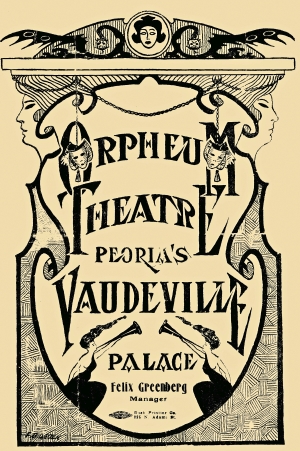With an outpouring of all classes of citizens such as this city has hardly witnessed in her entire history, Peoria last night splendidly demonstrated her appreciation of the new Orpheum theater when for the first time the beautiful playhouse was thrown open to the public.” —Peoria Evening Star
On April 24, 1911, Peoria, Illinois, officially landed on the national Orpheum Circuit. Located just north of Main Street on Madison Avenue, its Orpheum Theatre was considered on par with the finest theaters in New York and Chicago—viewed by proud locals as proof of the city’s vibrant growth and development.
The exquisite structure was built by Albert and Edward C. Leisy of the Leisy Brewery—then Illinois’ largest producer of beer outside of Chicago—and designed by Hewitt & Emerson, the architectural firm also responsible for the Grand Army of the Republic Memorial Hall and the Hotel Pere Marquette, among other iconic Peoria buildings. The Orpheum joined the Majestic Theatre and Pete Weast’s Golden Palace in hosting prominent national entertainers. With the opening of the Hippodrome two years later, Peoria’s vaudeville era was at its height.
 With 4,400 seats in the city’s four big vaudeville theaters (1,600 in the Orpheum alone—not to mention the smaller vaudeville houses), out-of-town visitors arrived daily by train, and performers played to full houses night and day, seven days a week. All of the big stars—Will Rogers, Sophie Tucker, Al Jolson, Jack Benny—played in Peoria, alongside up-and-coming acts trying to make the big time. If you could make it here, it was said, you could make it anywhere.
With 4,400 seats in the city’s four big vaudeville theaters (1,600 in the Orpheum alone—not to mention the smaller vaudeville houses), out-of-town visitors arrived daily by train, and performers played to full houses night and day, seven days a week. All of the big stars—Will Rogers, Sophie Tucker, Al Jolson, Jack Benny—played in Peoria, alongside up-and-coming acts trying to make the big time. If you could make it here, it was said, you could make it anywhere.
But the golden days of vaudeville were not to last. One could see the beginning of the end on October 26, 1920, when Peoria’s new “movie palace” opened its doors right across the street from the Orpheum. As the Madison Theater ushered in the age of motion pictures, vaudeville theaters became its casualty.
Some made the jump to movies: Weast’s became the Lyceum and reopened as a movie theater, the Hippodrome became the Rialto. The Orpheum was not so fortunate. Despite attempts to augment its live shows with newsreels, silent serials and prize giveaways, it was dead by the end of the Roaring Twenties.
In November of 1951, the Peoria Star was on the scene as the Orpheum Theater’s stage, seats and balconies were dismantled to prepare for the building’s imminent demolition. A brand-new parking lot (“which will accommodate an estimated 55 cars”) was set to take its place.
Bawdy old Peoria was being reformed. Sleek, modern office buildings were scraping the skies, and a new interstate highway would soon slice right through the heart of downtown. Parking lots were progress, and in January of ‘52, Peoria’s Orpheum was reduced to rubble. Barely four decades old, the building had sat dark more than half its life—its glory days as a vaudeville theater lasted a mere 16 years. a&s
For news clippings, old advertisements and more stories of Peoria’s Orpheum Theatre, check out our blog post “From Vaudeville Grandeur to… Parking Lot.“


